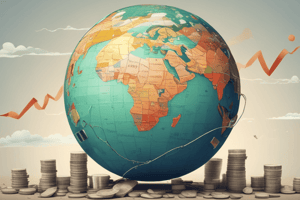Podcast
Questions and Answers
How does core inflation differ from the CPI?
How does core inflation differ from the CPI?
- Core inflation excludes volatile food and energy categories. (correct)
- Core inflation includes food and energy prices.
- Core inflation is based on individual-level surveys.
- Core inflation focuses on retail sales data.
What is the primary focus of the Personal Consumption Expenditures (PCE) Price Index?
What is the primary focus of the Personal Consumption Expenditures (PCE) Price Index?
- Food and energy prices
- Consumer choices (correct)
- Retail sales data
- Individual level inflation behavior
In what way do central banks utilize inflation data in monetary policy decisions?
In what way do central banks utilize inflation data in monetary policy decisions?
- To adjust interest rates and economic tools (correct)
- To regulate international trade agreements
- To control government spending
- To predict stock market fluctuations
What purpose does measuring inflation through indices like the CPI serve for investors, policymakers, and citizens?
What purpose does measuring inflation through indices like the CPI serve for investors, policymakers, and citizens?
Why is it important to exclude food and energy prices in core inflation calculations?
Why is it important to exclude food and energy prices in core inflation calculations?
What is the primary purpose of measuring inflation?
What is the primary purpose of measuring inflation?
How does inflation impact the purchasing power of money?
How does inflation impact the purchasing power of money?
Which organization calculates the Consumer Price Index (CPI)?
Which organization calculates the Consumer Price Index (CPI)?
What are the categories into which the Consumer Price Index (CPI) is divided?
What are the categories into which the Consumer Price Index (CPI) is divided?
How does the Consumer Price Index (CPI) help policymakers?
How does the Consumer Price Index (CPI) help policymakers?
Flashcards are hidden until you start studying
Study Notes
Understanding Inflation and Its Measurement
Measuring inflation is crucial for understanding the overall health and direction of an economy. Economists employ various tools and methodologies to gauge changes in the general price level of goods and services over time. Let's delve deeper into the concept of inflation and explore the methods used to measure it.
What is Inflation?
At its simplest definition, inflation refers to an increase in the overall price level of goods and services in an economy over a specific period. Inflation reduces the purchasing power of money, meaning that the same amount of money buys fewer goods and services as time passes. This phenomenon has profound implications for individuals, businesses, and governments, affecting everything from savings accounts to national debts.
Measuring Inflation: The Consumer Price Index (CPI)
One of the most widely used indicators of inflation is the Consumer Price Index (CPI), which measures the average change in prices paid by urban consumers for a specified basket of goods and services. The CPI is calculated by the U.S. Bureau of Labor Statistics and is divided into eight main categories: food, housing, apparel, medical care, recreation, transportation, education and communication, and other goods and services. The CPI helps identify trends in inflation, enabling policymakers to make informed decisions about interventions and fiscal policies.
Other Inflation Indicators
Apart from the CPI, other measures are used to assess inflation. One such indicator is the Personal Consumption Expenditures (PCE) Price Index, which focuses on personal consumption expenditure data collected through surveys and retail sales. This alternative approach provides insights into the behavior of inflation at the individual level and how it impacts consumer choices.
Additionally, the term "core inflation" is often mentioned alongside the CPI and PCE. Core inflation is essentially the CPI without the volatile categories of food and energy, offering a more stable, consistent view of pricing shifts in the broader economy. By isolating these elements, analysts can better understand the underlying dynamics driving inflation.
The Role of Central Banks in Measuring Inflation
Central banks, particularly the Federal Reserve, monitor inflation rates closely to inform their monetary policy decisions. By understanding the current rate of inflation, central banks can adjust interest rates and other economic tools to either combat rising prices (inflation) or stimulate growth when prices are falling (deflation). This ongoing assessment and intervention contribute to maintaining price stability in the economy.
In conclusion, measuring inflation through indices like the Consumer Price Index and Personal Consumption Expenditures Price Index plays a critical role in assessing the overall health of an economy. Understanding these measures allows investors, policymakers, and citizens better insight into the forces shaping economic trends.
Studying That Suits You
Use AI to generate personalized quizzes and flashcards to suit your learning preferences.




